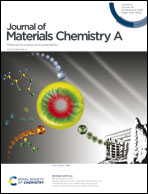The benzyl viologen radical cation: an effective n-dopant for poly(naphthalenediimide-bithiophene)†
Abstract
Despite the high performance of poly[N,N′-bis(2-octyldodecyl)-1,4,5,8-naphthalenediimide-2,6-diyl]-alt-5,5′-(2,2′-bithiophene) (pNDI-2T) in field-effect transistors, literature reports on its electrical conductivity upon n-doping using various n-dopants seem to show an upper limit in the range of 10−3 S cm−1. Here we demonstrate that by using the benzyl viologen radical cation (BV˙+) as an n-dopant, we have achieved electrical conductivity as high as 1.34 × 10−2 S cm−1 with minimum contact resistance. Moreover, electrical conductivities of the BV˙+-doped pNDI-2T films were found to be very stable; less than 30% degradation at both 100 °C for 24 h and room temperature for two weeks in a glovebox. This is in stark contrast with the commonly used tetrakis(dimethylamino)ethylene (TDAE) where the electrical conductivity of TDAE-doped pNDI-2T films falls rapidly within hours at room temperature. Detailed studies suggest that BV˙+ facilitates charge transport of pNDI-2Tvia reducing the electron hopping distance and minimizing structural rearrangement involving electron transfer. Our results may pave a way towards high electrical conductivity for n-doped conjugated polymers.



 Please wait while we load your content...
Please wait while we load your content...